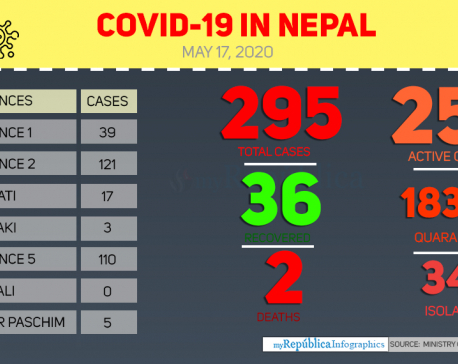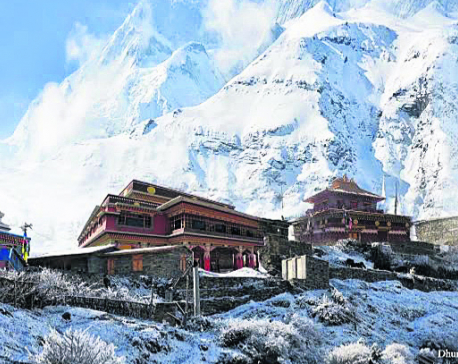
OR
#Opinion
Nepal’s Dreams of Hydro Dollars
Published On: February 3, 2023 07:37 AM NPT By: Hari Prasad Shrestha

More from Author
- Why Federalism has Become Risky for Nepalese Democracy
- Hunger is a Serious Problem in South Asia
- Tourism Can Be A Catalyst For Change in Karnali Province
- Nepal’s Southern Border Has Become An Open Regional Crossroads
- Opening a new gateway for Kailash Mansarovar Yatra through Nepalgunj-GunshaNagari flight
Hydropower in Nepal is a high prospective sector and it is one of Nepal's greatest economic assets after tourism. Nepal can convert hydropower into hydro dollars by exporting it to its neighbors who are facing an acute shortage of electricity. It would also narrow down the excessively widening balance of trade gap.
It is linked with national production and revenue generation as the government will receive a considerable amount of revenue from increased economic activities supported by cheap and reliable electricity. The everlasting nature of rivers and the mountainous topography provide ideal conditions for the development of some of the world’s largest hydroelectric projects in Nepal and the only product Nepal can export, on a massive scale, is hydropower.
Being one of the best renewable energy sources, hydropower produces no more direct waste and has very less output level of a greenhouse gas compared to other fossil fuel plants based on oil, coal and gas. Since hydropower relies only on the energy from moving water, it costs less than most energy sources.
The first hydro power project in Nepal, the Pharping hydro power project, was installed in 1911 with a capacity of 500 kilowatts of electricity. It was one of the largest hydro power projects in South Asia during that time. Nepal has the potential to produce 43000 MW of economically viable electricity from hydropower and its current power generation capacity is merely 2200 MW. After more than hundred years of its operation, producing about just two percent of its economically viable potential portrays a grim picture of the hydropower sector in Nepal.
During the independence of Bangladesh, its per capita income was parallel to Nepal, but now Bangladesh’s economy is 10 times larger than Nepal’s; energy was one of the primary sectors to support the economic activities there. The drawbacks of the hydroelectricity sector in Nepal are lower consumption, high tariff rates, high generation cost and dependence on a single country for exports.
The average annual per capita electricity consumption in Nepal is 350 kWh, which is the lowest among South Asian countries. The high tariff rate of electricity is one of the reasons for low power consumption. And Nepal’s high tariff rate is the result of a heavy reliance on bilateral and multilateral agencies, extensive employment of international consultants and contractors, difficult terrain, lack of required power supply infrastructures to industrial areas, least use of household cooking appliances to replace gas due to poor transmission infrastructures and insufficient in-house construction and manufacturing capabilities.
The average hydropower generation cost for a large project in Nepal is US$ 2 million for 1 MW, which is much higher than the international average cost. If we could reduce generation costs with increased efficiency, there are tremendous opportunities for investment in this sector.
As a result of the pending new electricity bill in parliament , the Nepal Electricity Authority is unable to enter into a new Power Purchase Agreement (PPA) with power producers and the private sector is unable to obtain permission to trade in electricity to reach the electricity market from the domestic to the regional level.
Currently India is the single electricity importer from Nepal and the Indian policy plays a vital role regarding the export of Nepal’s electricity. India's electricity policy is protective and fluctuating. The foreign hydropower investors in Nepal, other than Indians, would hardly be allowed to export electricity from Nepal there.
According to the Guidelines for Import/Export (Cross Border) of Electricity- 2018 for approval procedure of India “All Import/Export of electricity shall take place only after approval of the Government of India. All such approvals may be reviewed by the Govt of India as and when deemed necessary by it.”
Although Nepal is exporting limited quantities of electricity after receiving approval from India, it seems not easy to export bulk electricity, in future directly to the Indian market with this provision of pre-approval from the Government of India, which is not in compliance with pre-established market rules. This unclear and risky provision of pre-approval could discourage large investors in the hydropower sector in Nepal.
Currently, for transfer of bulk power, interconnection between India and Nepal through the Dhalkebar (Nepal) - Muzaffarpur (India) 400kV D/C transmission line has been constructed and a 400kV D/C Gorakhpur (India) – Butwal (Nepal) transmission line is under construction.
Bangladesh has also decided to import power from Nepal via the Indian territory, and India has agreed to allow it to use its transmission lines, which have capacity to transfer only 40 to 50 MW of electricity. According to Bangladeshi media, India has promised to cooperate for the import of electricity from Nepal to Bangladesh. And both the countries are in dialogue to construct a dedicated transmission line of higher capacity in India to import power from Nepal to Bangladesh. Bangladesh has also planned to import 9000 megawatts of electricity from Nepal by 2040. Bangladesh and Nepal have also agreed for the construction of Sunkosi third hydropower project in Nepal with a total capacity of 683 megawatts for power export to Bangladesh.
With the objective to export electricity from Nepal, currently, several hydro electricity projects are under construction in different parts of Nepal. Nepal signed agreements with GMR ITD Consortium of India for the construction of the 900 MW Karnali project and with Satluj Jal Vidyut Nigam of India to build the 900 MW Arun 3 project.
Similarly, under BRI project Nepal and China have agreed to construct 762MW Tamor hydroelectricity project; 426MW Phuket Karnali hydroelectric project in Nepal and Galchhi-Rasuwagadhi-Kerung 400kv transmission line between Nepal and China. This 70km project can carry 5,000MW of electricity, and would open the doors for power trade between Nepal and China.
After the expansion of China railway through Nepal to South Asia and through Pakistan to the Arabian Sea, the underdeveloped Chinese provinces of Xinjiang and Tibet are expected to be the new manufacturing powerhouses. And importing energy from Nepal to these provinces would be more viable and cheaper for China.
Moreover, the US under MCC project is also constructing a 315 km-long 400kV transmission in different parts of Nepal connecting from Kathmandu to Hetauda -Damauli - Butwal and to the Indian border, which is part of the cross-border transmission line between Nepal and India.
The Nepal Electricity Authority and the Nepali private sector are also investing in the construction of hydropower projects in the country. Currently, they are constructing more than 150 hydro projects with the capacity of more than 3,000 MW, which will be completed by next 2-3 years. The Government of Nepal has decided to construct a 1200 MW Budhi Gandaki Hydropower Project with its own resources as external debt in the hydropower sector could be a debt trap in the long run. In total, at present tens of thousand MW of hydro power projects are under different stages from feasibility study, financing, tender and under construction in Nepal.
The growing interest of neighboring investors in Nepal’s hydropower reaffirms that energy is an area where all the countries of South Asia have much to gain through cooperation, and Nepal’s surplus electricity would fulfill their power demands at a considerable level. It would support transforming Nepal’s economy in a new horizon by fulfilling Nepal's dreams of earning hydro dollars.
The only concern is how the Nepal government would deal and manage by facilitating concerns and problems to export electricity without hindrances to India and other South Asian countries through India and beyond. It is also equally important to ratify, urgently, the new electricity bill of Nepal from parliament for smooth power trading by the private producers.
You May Like This

Health ministry confirms three new COVID-19 cases, number of total cases reaches 295
KATHMANDU, May 17: Nepal reported three new cases of COVID-19 on Sunday evening, taking the national tally to 295. ... Read More...

Lower Modi project to generate power within a month
KUSHMA, Sept 23: The Lower Modi Hydropower Project located in Parbat district is expected to generate hydroelectricity within a month, the... Read More...

Dhurmus, Suntali to build ‘a Nepal within Nepal’
KATHMANDU, June 5: After successfully completing three settlement projects for earthquake victims and other communities, the actor couple Sitaram Kattel (Dhurmus)... Read More...




Just In
- Health ministry to conduct ‘search and vaccinate’ campaign on May 13
- Indian customs releases trucks carrying Nepali tea, halted across Kakarbhitta
- Silent period for by-election to begin from midnight
- SC issues short-term interim order to govt and TU not to take immediate action against TU legal advisor Khanal
- National consultation workshop advocates to scale up nutrition smart community in Nepal
- Patan High Court issues short-term interim order to halt selection process of NTB’s CEO
- NEPSE inches up 0.15 points; daily turnover increases to Rs 2.53 billion
- Bagmati Govt mandates tri-lingual signboards in offices















Leave A Comment